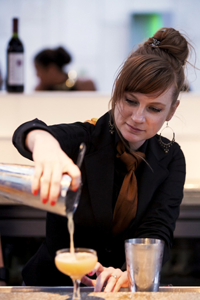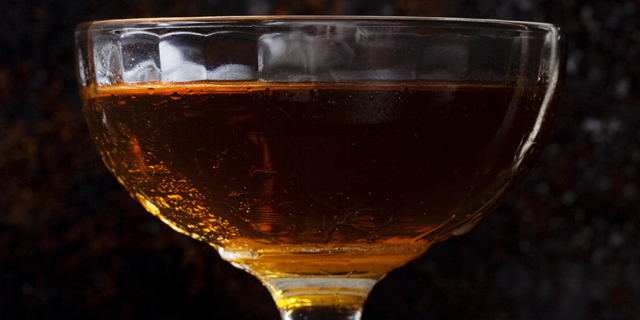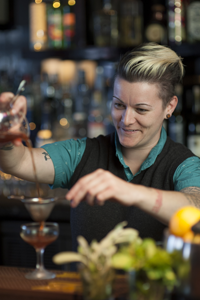Are bitters the next big thing?
Depending upon whom you ask, the answer may be: Bitters already are the next big thing. Jabe Amato, head bartender at Bistango Restaurant in Irving, California, says he can only speculate why bitters are suddenly becoming so popular, but suggests it’s most likely due to TV shows like Mad Men, which have triggered an interest not only in old school fashion, but also in old school cocktails. Many of these feature bitters such as Peychaud’s, which dates to the early 19th century, and Angostura, which was named for and developed in Angostura (now Ciudad Bolívar), Venezuela in 1824 by a German surgeon in Bolívar’s army.
Though liquor stores have long-stocked a basic range of bitters—orange and lemon, for example– more professional bartenders and mixologists are beginning to make their own small-batch bitters. Many of them are using local, seasonal ingredients, stocking their bars with custom-created flavors like cinnamon, chipotle, and pumpkin, or even, in the case of Jen Queen (right), principal bartender at San Diego’s Saltbox Dining and Drinking, sea urchin.
But maybe we’re getting ahead of ourselves.
What are bitters, anyway?
“Bitters are like the salt of the cocktail world,” says Mark Sexauer, author of the book Aphrodisiacs with a Twist ; they are used sparingly and purposefully to add complexity and flavor to a drink. To understand what bitters are, though, you first have to know what a tincture is: an infusion of one ingredient, such as cloves, into a high proof spirit; rum is a popular choice. Bitters are made by combining multiple tinctures.
If you want to understand what bitters add to a cocktail, Sexauer recommends that you make two classic Manhattans: one with two dashes of bitters and one without bitters. “Sip each one and experience the extreme difference,” he said. “They are two completely different drinks.”
Next, how you can make bitters at home…
[pagebreak]How can you make them at home?
“Making bitters is a lot of fun and there are several ways to do so,” says Chris Milligan, head mixologist at Santa Fe’s Secreto Lounge. Milligan knows a thing or two about the subject: he wrote the section on making bitters for the United States Bartender Guild’s Master Mixologist Accreditation Study Guide. You can find his basic instructions here.

“Use scrupulously clean jars and label them,” says Sam Meyer, a cocktail blogger based in Queens, New York. Meyer, who has 28-30 handcrafted bitters on hand at home, says clean jars prevent the transfer of unwanted flavors into your bitters. And labels? Well, once you start experimenting, “the kitchen can definitely fill up with murky jars quickly.”
His other piece of clutch advice? Experiment a lot. The more you play around with bitters, the more you’ll learn. “Fresh ingredients will extract differently from dried, and the higher the alcohol percentage [of your spirit of choice], the easier and quicker it will extract flavors,” he adds. When using spices and aromatics, Meyer recommends toasting them in a clean, dry, heavy skillet to draw out their full flavors. Finally, he says, don’t dismiss spirits you don’t necessarily enjoy drinking straight. “For my lime bitters,” he says, “I use J. Wray & Nephew white overproof rum from Jamaica, which doesn’t taste that wonderful to me on its own (well, to me it tastes a bit like I imagine kerosene to) but is great at picking up other flavors.”
Where can you source unusual ingredients?
Bitters lend themselves to unusual ingredients, but for people living outside major cities, such ingredients might be hard to find. Fortunately, mail-order services can help out. In New York, Sam Meyer recommends Kalustyan’s, an Indian store with a wide range of international spices. Specialty food shops and old-fashioned apothecaries are also ideal places to source bitters ingredients. Meyer says Tenzing Momo and Dandelion Botanical Company, both in Seattle, have active mail-order operations.
What kinds of Latin-inspired flavors would work well as bitters?
Ingredients we identify with la cocina latina work really well in bitters. Ben Molina, co-owner and bartender of Cinco, a Oaxacan cantina and cocina in the Los Angeles area, says avocado leaves, allspice, cilantro, citrus peels, and dried chiles are all good choices. Lauren Lathrop Williams, assistant manager at Jsix t recommends using earthy or smoky flavors rather than bright, fresh ingredients. “I would use a smoky chipotle or fire roasted chili instead of fresh jalapeño or Serrano,” she says. “Florals like hibiscus or a pulpy fruit like tamarind also work very well,” she says.”
Chris Milligan of Secreto Lounge agrees that Latin flavors lend themselves to bitters and that these bitters can be very complimentary to certain Latin liquors. “So many of them go with the flavors south of the border,” he says. “Mezcal likes a smoky flavor. Cachaca and pisco do well with fruit-based bitters.”
Inspired? Next, our basic bitters recipe and a bitters cocktail recipe to try…
[pagebreak]- 1/2 teaspoon gentian
- 1/4 teaspoon quassia chips
- chunk cinchona bark
- 2 cups grain alcohol
- 3 cinnamon sticks
- 1 teaspoon cloves
- 25 whole allspice berries
- 2 star anise
- 7 cracked cardamom pods
- 1/2 teaspoon crushed mace blades
- 2 ounces añejo tequila
- 1 ounce sweet vermouth
- 3 big dashes of chocolate bitters





![Making Mealtime Matter with La Familia: Easy Sofrito [Video]](https://thelatinkitchen.com/wp-content/uploads/2015/10/sofrito-shutterstock__0-500x383.jpg)
![Easy Latin Smoothies: Goji Berry Smoothie [Video]](https://thelatinkitchen.com/wp-content/uploads/2015/12/goji_berry-shutterstock_-500x383.jpg)
















![Fun and Fast Recipes: Fiesta Cabbage Salad [Video]](https://thelatinkitchen.com/wp-content/uploads/2015/11/fiesta_cabbage_slaw-shutterstock_-500x383.jpg)









